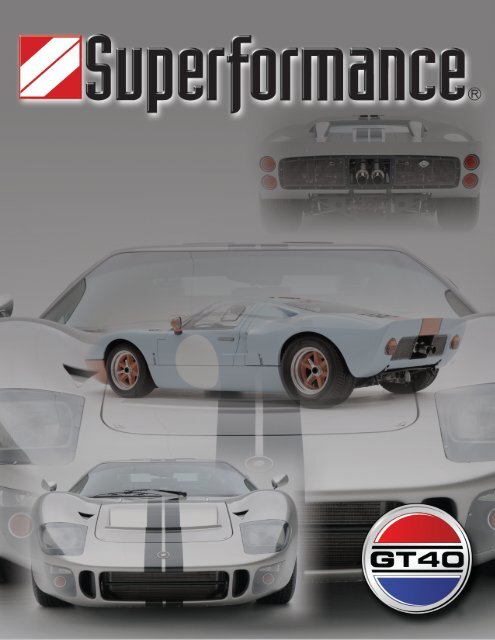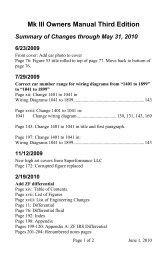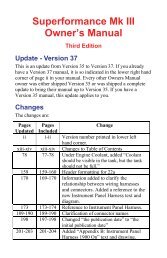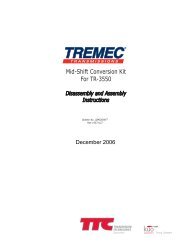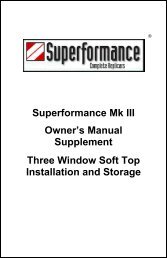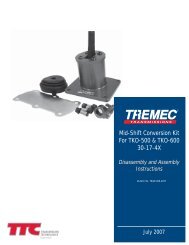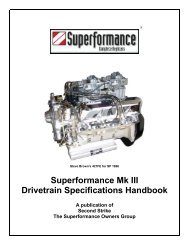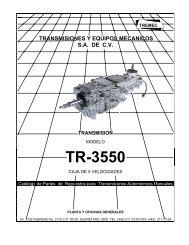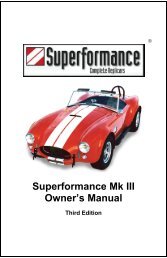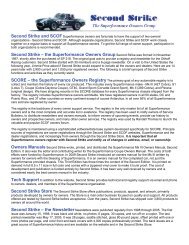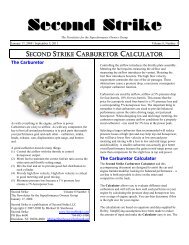GT40 Owners Manual - Second Strike
GT40 Owners Manual - Second Strike
GT40 Owners Manual - Second Strike
Create successful ePaper yourself
Turn your PDF publications into a flip-book with our unique Google optimized e-Paper software.
Owner’s <strong>Manual</strong><br />
Operational Guide<br />
Warranty<br />
1
Authorized Dealer<br />
Superformance Chassis Number:<br />
Model:<br />
Color:<br />
Stripes:<br />
Purchased by:<br />
Purchase Date:<br />
______________________________<br />
______________________________<br />
______________________________<br />
______________________________<br />
______________________________<br />
2
Superformance® <strong>Owners</strong> <strong>Manual</strong>, Operational<br />
Guide, and Warranty<br />
Copyright © 1998-2002 by Superformance LLC.<br />
Superformance® is a registered trademark of<br />
Superformance LLC.<br />
Printed in RSA.<br />
3
To the lucky new owner of this <strong>GT40</strong><br />
Brady Pack, John Sadler, and Bob Wood, the three<br />
partners of Safir <strong>GT40</strong>® Spares, Limited, would like to<br />
congratulate you on the purchase of this rare vehicle. As<br />
you might or might not know, Safir <strong>GT40</strong>® Spares,<br />
Limited holds the rights to the famous <strong>GT40</strong>® trademark,<br />
and supplies parts and technical information to the owners<br />
of the original <strong>GT40</strong>® cars. Safir also keeps the records of<br />
the MkVs, and with Superformance will maintain a registry<br />
of your car. These registries are combined at various<br />
times with the registry of The Shelby American<br />
Automotive Club, and the written works of such <strong>GT40</strong>®<br />
authorities as Ronnie Spain and John Allen.<br />
We hope that you will enjoy this <strong>GT40</strong>® as much as we<br />
and so many others do enjoy our cars. The<br />
Superformance <strong>GT40</strong>® allows you, the owner, to drive a<br />
high performance sports car while at the same time<br />
offering a comfortable ride with room to thrill a passenger!<br />
The styling is unique and true to the original cars, and the<br />
build quality and the attention to detail of Hitech<br />
Automotive and Superformance makes this vehicle worthy<br />
of the great <strong>GT40</strong>® name. You will now be driving a<br />
descendant of the car that became the “Legend of<br />
LeMans”. Drive carefully, good luck, and enjoy the ride!<br />
Brady Pack<br />
John Sadler<br />
Bob Wood<br />
4
Lance Stander of Superformance LLC and Jimmy Price of<br />
Hi-Tech Automotive would like to extend their thanks and<br />
congratulate you on your purchase of the Superformance<br />
<strong>GT40</strong>. You now own a piece of one of the greatest<br />
accomplishments in racing history. With four victories at<br />
Le Mans the <strong>GT40</strong> assured its immortality in the minds of<br />
motor sports enthusiasts world wide. Four years of<br />
development went into the recreation of the SPF <strong>GT40</strong> and<br />
the result is a masterpiece of beauty that is evident to the<br />
eye matched with precision engineering that can only be<br />
measured from behind the wheel. An intimate connection<br />
between driver and car. One that can only be explained<br />
through the driving experience. We hope that you enjoy<br />
your Superformance <strong>GT40</strong> and the memories that are yet<br />
to be created.<br />
On behalf of the entire Superformance and Hi-Tech family<br />
we thank you for your purchase and hope you enjoy its<br />
history, beauty, and performance for many years to come.<br />
Now you can have your cake and eat it too!<br />
Lance Stander<br />
Jimmy Price<br />
5
GENERAL SPECIFICATIONS<br />
Congratulations on your purchase of a Superformance® component<br />
vehicle! With proper care and maintenance your Superformance<br />
should supply you with years of pleasure and enjoyment. Prior to<br />
operation please familiarize yourself with the information contained in<br />
this book.<br />
[Figure 1 - Superformance <strong>GT40</strong>]<br />
The vehicle is supplied by Superformance as a complete and fully<br />
equipped rolling chassis less engine and transmission. Please check<br />
with the installer of your engine and transmission for break-in details<br />
and specifications for your engine and transmission and record the<br />
information in the space provided in this manual.<br />
Superformance makes running engineering changes as requirements<br />
are identified. The specifications herein are typical for cars in current<br />
production at the time of compilation of this manual. Specifications<br />
for individual cars may vary.<br />
6
Chassis:<br />
Jig-Welded monocoque.<br />
Body:<br />
Composite construction. Hand laid fiberglass panels with Vinyl ester<br />
resin.<br />
Front suspension:<br />
Original style, fully independent suspension using unequal length A-<br />
arm design, coil springs over telescopic shock absorbers, adjustable<br />
ride height and anti roll bar.<br />
Rear suspension:<br />
Original style, fully independent suspension using radius rods,<br />
unequal length A arm design, with a toe control link, adjustable coil<br />
springs over telescopic shock absorbers, adjustable ride height and<br />
anti roll bar.<br />
Steering:<br />
Rack and pinion with 2.5 turns lock to lock.<br />
Pedal box:<br />
Floor mounted pedals. Adjustable pedal box.<br />
Brakes:<br />
Non-assisted brake system. Separate front and rear master<br />
cylinders. Adjustable front to rear brake bias via balance bar.<br />
Calipers:<br />
Front -<br />
Rear -<br />
4-pot<br />
4-pot<br />
Ventilated discs:<br />
Front – 12.75” x 1.25”<br />
Rear – 12.75” x 1.25”<br />
Cooling:<br />
High performance aluminum two-core radiator. Two<br />
thermostatically-controlled electric fans.<br />
Exhaust system:<br />
7
Original style fabricated headers (bundle of snakes) incorporating<br />
full crossover design.<br />
Interior:<br />
The cockpit is trimmed in top quality automotive carpeting, and<br />
Alcantara. 4-point seat belts. Original style 14” Motolita<br />
steering wheel. Rear view mirror.<br />
Your Superformance <strong>GT40</strong> has 2 stowage compartments. These are<br />
located in each of the doors.<br />
MECHANICAL COMPONENTS<br />
Engine:<br />
As the Superformance <strong>GT40</strong> is a copy of the original <strong>GT40</strong> chassis, it<br />
can therefore accommodate anything from a 302 small block to a<br />
427FE big block.<br />
Drive train:<br />
The Superformance <strong>GT40</strong> can use a choice of either ZF 5-DS25 or<br />
T44 Transaxles.<br />
Front Wheels:<br />
Aluminum 15" x 8” “Halibrand” or “BRM” pattern peg drive.<br />
Rear Wheels:<br />
Aluminum 15” x 10” “Halibrand” or “BRM” pattern peg drive.<br />
Tires:<br />
Front -<br />
Rear -<br />
225/50 R-15 (Recommended MkI & MkII)<br />
295/50 R-15 (Recommended MkI)<br />
275/60 R-15 (Recommended MkII)<br />
Fuel Tank:<br />
Two stainless steel tanks connected via crossover line. 10.5 gallon<br />
each.<br />
8
DIMENSIONS:<br />
Wheelbase: 95”<br />
Length: 163”<br />
Height: 40.5”<br />
Width: (Overall) 70”<br />
Track Front: 57”<br />
Track Rear: 56”<br />
Ground clearance: 4.125”- 4.75”<br />
Curb Weight:<br />
2400lbs<br />
Weight distribution: F/R: 40 / 60%<br />
9
INSTRUMENTATION<br />
Full instrumentation, gauges and warning lights, are provided with the<br />
Superformance rolling chassis. The gauges and warning lights must<br />
be correctly hooked up during the engine and transmission installation<br />
to function properly. The gauge and warning light readings are<br />
dependant on engine and transmission specifications and installation<br />
procedures. The following information is therefore provided as general<br />
guidelines only. The actual gauge readings should be determined by<br />
the owner and written in the spaces provided.<br />
[Figure 2 - Instrumentation]<br />
10
Speedometer:<br />
The speedometer (1) indicates the speed of the car in miles per<br />
hour.<br />
Tachometer:<br />
The tachometer (2) indicates the engine speed in revolutions per<br />
minute. Your engine provider should specify the minimum and<br />
maximum engine speeds for the engine you have selected.<br />
Minimum engine speed:<br />
______ rpm<br />
Maximum engine speed, break in:______ rpm for ______ miles<br />
Maximum engine speed: ______ rpm<br />
Water Temperature Gauge:<br />
The water temperature gauge (3) indicates the engine water<br />
temperature in degrees Centigrade. The normal operating<br />
temperature depends on the thermostat installed. Thermostats are<br />
normally rated in degrees Fahrenheit. The following table shows the<br />
expected water temperature gauge reading in normal driving for<br />
several typical thermostat ratings. Your engine provider should<br />
specify the normal water temperature.<br />
Quick conversion table:<br />
Degrees Fahrenheit Degrees Centigrade<br />
150 66<br />
160 71<br />
170 77<br />
180 82<br />
190 88<br />
200 94<br />
210 99<br />
220 104<br />
230 110<br />
Normal water temperature: __________ degrees Fahrenheit<br />
If the water temperature exceeds 230 degrees Fahrenheit, the engine<br />
should be shut down and allowed to cool before proceeding. Water<br />
temperatures above 210 degrees Fahrenheit during normal driving<br />
indicate a problem that needs to be corrected<br />
11
Oil Temperature Gauge:<br />
The oil temperature gauge (4) indicates the engine oil temperature<br />
in degrees Centigrade. The oil temperature during normal driving<br />
should be approximately the same as the water temperature. It will<br />
be somewhat lower until the engine fully warms up and during cold<br />
weather. It will be higher during high speed driving. If the oil<br />
temperature exceeds the maximum during high speed driving,<br />
additional oil cooling capacity may be required.<br />
Normal oil temperature:<br />
Maximum oil temperature:<br />
__________ degrees Centigrade<br />
__________ degrees Centigrade<br />
Fuel Gauge:<br />
The fuel gauge (5) indicates the fuel level in the fuel tank.<br />
Ammeter:<br />
The ammeter (6) indicates whether the battery is charging (+ to the<br />
right) or discharging (- to the left). The gauge will typically show<br />
significant charging just after starting the car, then settle into a<br />
slight charge just to the right of center.<br />
Oil Pressure Gauge:<br />
The oil pressure gauge (7) indicates the oil pressure in pounds per<br />
square inch (PSI). Your engine provider should specify the<br />
minimum and maximum oil pressure for the engine you have<br />
selected. If the oil pressure drops below the minimum, it may<br />
indicate a serious problem. The engine should be shut down<br />
immediately until the problem is identified and corrected.<br />
Minimum oil pressure:<br />
Maximum oil pressure:<br />
__________ PSI at __________ rpm<br />
__________ PSI at __________ rpm<br />
12
CONTROLS AND SWITCHES<br />
[Figure 3 Controls and switches]<br />
Ignition Switch:<br />
The ignition switch (9) has 3 positions:<br />
1 – Ignition “OFF” – Key in middle position.<br />
2 - Accessory – Key turned counterclockwise<br />
Only the DC accessory power ports have electrical feed with the<br />
ignition switch in this position.<br />
3 – Ignition “ON” – Key turned clockwise<br />
This switch position activates all functions which require electrical<br />
feed.<br />
Turn Signal Indicator / Hi Beam Stalk:<br />
The turn signal stalk / lever (10) is mounted on the steering<br />
column, typically on the left hand side. Move the stalk in the<br />
direction you want to turn to activate the turn signal. The high/low<br />
beam switch is integrated with the turn signal stalk. When the<br />
13
headlights are turned on, pull the stalk to switch between high<br />
beams and low beams. When the high beams are on, the hi-beam<br />
pilot light will be on. When the headlights are not on, pulling the<br />
stalk flashes the high beams.<br />
Horn:<br />
The horn button is located at the end of the turn signal stalk.<br />
Pushing the button sounds the horn.<br />
Dash dimmer switch:<br />
The dashboard dimmer switch (11) is situated on the dash and is<br />
used to control the intensity of the dashboard lights. Turn the<br />
dimmer switch counterclockwise to dim the dashboard lights and<br />
clockwise to brighten them.<br />
Start Button:<br />
This button (12) is depressed to start the engine.<br />
(See Start Procedure on page16)<br />
Fuel Pump Toggle Switch:<br />
The fuel pump switch (13) controls the electric fuel pump. Up is off<br />
and down is on. Be sure to turn the fuel pump on before starting<br />
the car. Although the electric fuel pump shuts off when the ignition<br />
is turned off, it is a good idea to turn off the electric fuel pump<br />
switch as well. Remember to turn it back on when you start the car.<br />
If the pump is switched off (up), the car may start, but will shut<br />
down in a short while when the fuel supply in the carburetor bowl is<br />
used up.<br />
Radiator Fan Override Toggle Switch:<br />
The radiator fans are switched on automatically when the engine<br />
temperature exceeds 203 to 207 degrees Fahrenheit. The radiator<br />
fan override toggle switch (14) enables you to turn the radiator fans<br />
on manually when the water temperature gauge indicates that the<br />
engine temperature is approaching 203 degrees Fahrenheit,<br />
typically in slow traffic. Up is off and down is on.<br />
Windshield Washer Toggle Switch:<br />
The windshield washer can be activated by toggling switch (16)<br />
upwards or downwards<br />
14
Windshield Wiper Rotary Switch:<br />
The two speed windshield wiper switch (17) has 3 positions<br />
P Park (off)<br />
N Normal (low) speed wiper<br />
H High speed wiper<br />
From park, rotate the switch clockwise one position for low speed<br />
wiper operation and two positions for high speed wiper operation.<br />
Rotate the switch counterclockwise to slow or turn off the wipers.<br />
Headlight Toggle Switch:<br />
Toggle the headlight switch (18) to the full up position to turn off<br />
the lights. Toggle the switch down one position to turn on the<br />
running lights and down two positions to turn on the headlights. The<br />
dashboard lights come on automatically when the running lights or<br />
headlights are switched on.<br />
Spot Light Toggle Switch:<br />
Toggle the switch (19) downward to switch on the spot lights<br />
Number Light Toggle Switch:<br />
(Optional) All <strong>GT40</strong>’s have plugs in the door loom for the connection<br />
of a light on the door to illuminate the racing number. Toggle the<br />
switch (20) downward to activate this light.<br />
Indicator repeater:<br />
The indicator repeater (21) blinks to indicate that the turn signals<br />
are illuminated.<br />
Ignition / Alternator Warning Light:<br />
It is normal for the Ignition / alternator warning light (22) to be on<br />
when the ignition is on and the engine is not running. If the Ignition<br />
/ alternator warning light are on for more than a few seconds when<br />
the engine is running, it indicates a problem with the alternator. It<br />
may be that the v-belt is loose or missing. It may be an electrical<br />
problem. Immediate attention is required. A loose or missing v-<br />
belt can cause the engine to overheat.<br />
Hi Beam Pilot Light:<br />
The hi-beam pilot light (23) indicates that the headlight high beams<br />
are on.<br />
15
Radiator Fan Override Light:<br />
The radiator fan override light (24) will illuminate when the radiator<br />
fan override switch is activated.<br />
[Figure 4 – HVAC Control]<br />
Air flow directional:<br />
This control (1) has variable settings from face vent (full left) to<br />
footwell vents (full right), and any ratio of the two in between.<br />
Eg: If the control is half-way between ace and foot, then the airflow<br />
is 50% Face and 50% Foot.<br />
Demister control:<br />
The de-mister control (2) controls the amount of air directed<br />
towards the windscreen of the vehicle. Full left is off, and full right<br />
is on. You can control the amount of air directed to the windscreen<br />
with this control.<br />
Temperature control:<br />
This control (3) has regulates the temperature of the air entering<br />
the cabin through the vents from cold (full left) to hot (full right)<br />
16
Air flow source:<br />
The re-circulate button (4) determines whether the source of air is<br />
fresh or re-circulated.<br />
Air-Conditioning:<br />
Push Air-Conditioning button (5) to engage or disengage the air<br />
conditioning compressor.<br />
Adjustable air vents:<br />
These dash mounted vents are fully adjustable in all directions and<br />
are situated on the far left and right of the dash.<br />
DC power accessory ports:<br />
These can be used to supply power to 12 volt plug-in automotive<br />
accessories (See Figures 3 & 4 – item “A” above)<br />
Hand brake:<br />
To apply the hand brake, pull the handle upwards while depressing<br />
the button at the end of the lever. Release the button at the end of<br />
the lever’s travel. To release, press the button and lower the lever<br />
fully.<br />
17
START PROCEDURE:<br />
VEHICLE OPERATION<br />
1 Apply the handbrake and insert the key into the ignition.<br />
2 Depress the clutch pedal. Put the gear lever into neutral.<br />
3 Turn the key clockwise to position II to activate the<br />
electrical circuits.<br />
4 Turn on the fuel pump (See Figure 3 – item #13)<br />
(You should be able to hear it pressurizing the system).<br />
5 Turn the key to momentary position III or depress the start<br />
button to engage the starter motor. The engine should<br />
start immediately; if not, repeat the stages detailed above.<br />
IMPORTANT: Only short repeated engine cranking periods should<br />
be used, as long cranking periods cause unnecessary wear to the<br />
starter motor and cause un-burnt fuel to be deposited into the<br />
exhaust system.<br />
Turn the ignition switch counterclockwise to turn the engine off.<br />
The key cannot be removed from the ignition switch unless the<br />
ignition switch is in the off position.<br />
DO NOT engage the starter if the engine is running. Serious<br />
damage to the starter and engine can result<br />
DO NOT leave the ignition switched on when the engine is not<br />
running. Damage to the ignition system can result.<br />
RUNNING IN PROCEDURE:<br />
The benefits of gradually ‘running in’ your Superformance <strong>GT40</strong> are<br />
many and varied, but a major factor is to enable the new engine<br />
components to bed-in properly. For your vehicle to run at its<br />
optimum performance it is important that the car avoids high engine<br />
rpm and heavy throttle opening during the periods detailed below.<br />
18
Engine:<br />
Your engine builder should specify the correct running in procedure<br />
for your engine.<br />
Tires:<br />
It is advised that you should avoid excessive braking and cornering<br />
over the first 1000 mile period, in order to achieve and prolong<br />
maximum tire performance.<br />
Brakes:<br />
It is advised that excessive braking should be kept to a minimum<br />
during the first 500 miles of driving to bed in the friction materials.<br />
DOORS:<br />
To open the door from the outside, press on the back end of the<br />
handle, then pull (see Fig. 5)<br />
[Figure 5 – Opening the door from the outside]<br />
To open the doors from the inside, pull on the door release cable<br />
(see Fig. 6)<br />
19
[Figure 6 – Opening the door from the inside]<br />
IMPORTANT: Care should be taken when opening the door in<br />
windy conditions.<br />
[Figure 7 – Keys]<br />
Your car has a key for the ignition (1), a key for the locking gas<br />
cap (2), and a key for the snap-off steering hub (3). A spare of<br />
each of these keys is supplied with the vehicle.<br />
Record the key information below:<br />
Key: Name / Number<br />
Ignition _________ _________<br />
20
Locking gas cap _________ _________<br />
Steering hub<br />
_________ _________<br />
Front Clip/Hood<br />
The front clip is also known as the hood, bonnet or nose. It is<br />
secured in place by two original style lever type latches at the rear<br />
of the hood on the sides (see Fig. 8).<br />
Access under the hood is gained either by removing the front clip<br />
completely, or by lifting/removing the radiator outlet.<br />
[Figure 8 – Front Latch]<br />
Removing the front clip on your MkI:<br />
- Two persons are required to remove the front clip.<br />
- Unclip the latches on either side of the front clip.<br />
- If you own a MkI <strong>GT40</strong>, you need to completely remove the<br />
radiator outlet. To do this, release the ¼-turn fasteners<br />
located on the radiator outlet by turning them counterclockwise.<br />
The outlet can now be removed.<br />
- Unplug the headlight harness [see figure 9]. This is<br />
located just in front of the radiator on the left hand side.<br />
21
[Figure 9 – Headlight harness plug]<br />
- The front clip can now be removed by tilting it slightly<br />
forward to clear the fuel filler caps, and pulling it over the<br />
front of the vehicle.<br />
Removing the front clip on your MkII:<br />
- Two persons are required to remove the front clip<br />
- Unclip the latches on either side of the front clip.<br />
- If you own a MkII <strong>GT40</strong>, you need to hinge the radiator<br />
outlet open. To do this, release the ¼-turn fasteners<br />
located on the front of the radiator outlet counterclockwise.<br />
The outlet can now be hinged open.<br />
- Unplug the headlight harness (see Fig. 9). This is located<br />
just in front of the radiator on the left hand side.<br />
- The front clip can now be removed by tilting it slightly<br />
forward to clear the fuel filler caps, and pulling it over the<br />
front of the vehicle.<br />
Replacing the front clip:<br />
- As with the removal of the front clip, this task requires two<br />
persons.<br />
22
- With the nose tipped forward, align the hinge pins with the<br />
slot in the hinge plates (see below).<br />
[Figure 10 – Front Hinge plate & Hinge Pin]<br />
- Push the front clip towards the rear of the vehicle until it<br />
cannot go any further. Note: Extra care must be taken not<br />
to foul the front clip on the fuel filler caps as this may<br />
cause damage to the bodywork as well as to the fuel filler<br />
caps.<br />
- Fasten the front clip firmly in place with the latches on the<br />
either side.<br />
- Plug in the headlight harness.<br />
- Replace the radiator outlet and secure in position with the<br />
¼-turn fasteners.<br />
Rear clip/trunk<br />
The rear clip is also known as the trunk, boot or tail. It is secured in<br />
place by two original style lever type latches at the front of the<br />
trunk on the sides (see fig. 11) as well as a pin located on the top<br />
of the trunk right in the centre, just after the roof of the vehicle<br />
(see fig. 12).<br />
Access to the engine bay of the vehicle is gained be either tilting the<br />
rear clip backwards or removing it completely.<br />
23
[Figure 11 – Rear Latch<br />
[Figure 12 – Center Pin]<br />
Removing the rear clip:<br />
- Two persons are required to remove the rear clip.<br />
- Remove the centre pin.<br />
- Unclip the latches located on either side of the front clip.<br />
24
- With one person on either side of the rear clip, carefully tilt<br />
the clip backwards.<br />
- With one person holding the rear clip open, unplug the tail<br />
light harness.<br />
- Once the rear clip has been tilted to near vertical, it can be<br />
lifted off its hinge pins.<br />
[Figure 13 – Rear Hinge Plate and Hinge Pin]<br />
Replacing the rear clip:<br />
- Once again, two persons are required to replace the rear<br />
clip.<br />
- With the rear clip in the near vertical position, align hinge<br />
plates with the hinge pins (see fig. 13).<br />
- Hinge the rear clip forwards and down until it is in its final<br />
position.<br />
- Re-connect the tail light harness.<br />
- Lock the rear clip in position by replacing the centre pin<br />
and locking the lever style latches on either side.<br />
Re-fueling<br />
Two Le Mans vintage competition style gas filler caps are fitted just<br />
in front of the windshield base on either side of the vehicle [see<br />
25
figure]. It is recommended that you open both filler caps when refueling<br />
as both tanks are interconnected and this will allow the tanks<br />
to fill quicker.<br />
[Figure 14 – Filler Cap Location]<br />
To open the cap, press down on the latch.<br />
The cap will spring open. A locking type gas cap is fitted inside the<br />
Le Mans cap for additional security. The cap is locked and unlocked<br />
with the key provided. With the cap unlocked, turn the cap counterclockwise<br />
to remove it and clockwise to secure it. To close the Le<br />
Mans cap, press down on the cap until the latch catches.<br />
26
Seats<br />
GENERAL OPERATION<br />
The seats are custom moulded foam and are upholstered in<br />
Alcantara.<br />
They are not adjustable.<br />
Adjustment for leg length can only be done by means of the<br />
adjustable pedal box. It is recommended that you let your dealer<br />
set the pedal box to your requirements.<br />
Seat belts<br />
Your vehicle is fitted with a 4-point harness.<br />
ROUTINE MAINTENANCE<br />
Battery<br />
The battery recommended by Superformance is a sealed for life<br />
battery and therefore should not need regular maintenance or<br />
renewal.<br />
The battery is located in the engine bay in the right hand sill, under<br />
the oil cooler.<br />
To gain access to the battery, the panel upon which the oil cooler is<br />
mounted needs to be removed by loosening and removing the M6<br />
button-head cap screws with a 4mm Allen key.<br />
27
[Figure 15 - Battery location ]<br />
Wheels and tires<br />
The vehicle is fitted with either “Halibrand” or “BRM” pattern<br />
aluminum peg drive wheels with polished rim and painted center.<br />
[Figure 16 – The left side front and rear wheel spinners are<br />
loosened by turning them counterclockwise and tightened by<br />
turning them clockwise.]<br />
28
[Figure 17 – The right side front and rear wheel spinners are<br />
loosened by turning them clockwise and tightened by turning<br />
them counterclockwise.]<br />
If a wheel has to be removed, front or rear, the knock-on nut should<br />
be struck with a soft hammer (lead or urethane) in the direction of<br />
the wheel rotation when moving forward.<br />
When the nut has moved approximately a quarter of a turn, the car<br />
should be jacked up for the nut to be removed completely.<br />
CAUTION: Always use jack stands once the car is in the air. Jacks<br />
should only be used for lifting and never to support the vehicle.<br />
When replacing the wheel, the drive pins should bed up with the<br />
inner row of holes in the center of the wheel rim.<br />
29
[Figure 18 - Drive Pin Holes in Wheel Centre]<br />
[Figure 19 – Drive pins on hub centre]<br />
The spinner seating face should be coated with anti-seize compound<br />
before reinstalling.<br />
30
The spinner nut is tightened in the reverse direction to forward<br />
wheel rotation. It is recommended that the spinner nut be tightened<br />
with a urethane hammer rather than a lead hammer to avoid over<br />
tightening.<br />
As the vehicles do not carry spare tires, it is advisable for the user<br />
of this vehicle to keep on hand at all times an aerosol inflatable tire<br />
product.<br />
Tire pressures<br />
It is important to check the tire pressures regularly, in order to<br />
maintain maximum performance characteristics and prevent<br />
excessive tire wear.<br />
Recommended Values:<br />
Always refer to the tire manufactures inflation requirements located<br />
on the tire sidewall.<br />
ALIGNMENT SPECIFICATIONS<br />
CAUTION: These settings are critical to the drivability of your<br />
vehicle and must only be adjusted by skilled individuals with the<br />
necessary experience. Consult your local dealer for a specialist in<br />
your area<br />
NOTE: When taking your vehicle in for wheel alignment, we strongly<br />
recommend that you supply them with a copy of the information<br />
below, to enable them to determine if they are capable of these<br />
technical adjustments<br />
SUSPENSION SETTINGS<br />
Please take careful note to the fact that both the front and rear<br />
suspensions are extremely sensitive to any minor adjustments.<br />
When setting the car up do not make major adjustments, rather<br />
make small incremental adjustments until the desired bump steer<br />
settings have been achieved. Any large adjustments change the<br />
31
ump steer dramatically, which may cause you to think that it is<br />
impossible to achieve the suggested settings.<br />
RECOMMENDED SETTINGS<br />
Camber Angle<br />
Front<br />
Rear<br />
0.5-1.0º Neg<br />
0.5-1.0º Neg<br />
Toe<br />
Front<br />
Rear<br />
15 minutes Total<br />
15 minutes Total<br />
Castor Angle<br />
Front<br />
Rear<br />
Non-Adjustable<br />
7 – 8½º Adjusted to give<br />
minimum toe-in change in bump<br />
and rebound positions.<br />
Ride Height<br />
Front<br />
Rear<br />
4.125 – 4.5 inches<br />
4.5 – 4.75 inches<br />
Also – all of the settings and notes in this document are based on the<br />
recommended tires being fitted to the car.<br />
32
ROUTINE CHECK UP AND LUBRICATION<br />
After the first 1000 miles, and thereafter every 5000 miles, the<br />
vehicle should be thoroughly checked for loose nuts, bolts, etc.<br />
RECOMMENDED FLUIDS<br />
Engine oil:<br />
The engine oil change specifications depend on the engine installed.<br />
Your engine provider should provide the oil change specifications.<br />
Oil capacity: __________ quarts<br />
Oil type:<br />
Break in: ______________________<br />
Routine: ______________________<br />
High speed: ______________________<br />
Oil change interval<br />
Break in: __________ miles<br />
Routine: __________ miles<br />
High speed: __________ miles<br />
Transmission:<br />
The transmission fluid specifications depend on the transmission<br />
installed. Your transmission provider should provide the oil change<br />
specifications.<br />
Fluid capacity: __________ quarts<br />
Fluid type: ______________________<br />
Fluid change interval<br />
Break in: __________ miles<br />
Routine: __________ miles<br />
Brake and Clutch Fluid<br />
The brake and clutch fluid reservoirs are located in front of the<br />
windscreen base, under the nose, on either the left or right hand<br />
side.<br />
33
[Figure 20 – Brake & Clutch Fluid Reserviors]<br />
It is recommended that you check the levels from time to time. If<br />
the reservoir needs to be topped up, use DOT 3 or DOT 4 Brake<br />
and Clutch Fluid. The level of the fluid should not drop dramatically.<br />
If it does, consult your dealer<br />
CAUTION: Brake fluid is corrosive to paint. Use care not to spill<br />
fluid on the finish. Any spills should be immediately flushed away<br />
with fresh water.<br />
Header tank:<br />
The engine coolant water for the radiator can be filled at the header<br />
tank which is mounted on the rear firewall in the engine<br />
compartment on the right hand side.<br />
NOTE: Be careful when removing the header tank cap as the<br />
contents will be under pressure when hot.<br />
Filling engine oil<br />
The engine oil filler cap is located on top of the LHS engine valve<br />
cover. To remove, simply pull upward. Check the engine oil level<br />
using the dip stick situated at the RHS front of the engine. Pull the<br />
dip stick out and wipe clean to ensure a true reading.<br />
34
Re-insert the dip stick and remove once again.<br />
The level of oil should read between the min and max marks on the<br />
dip stick. Top up with the recommended oil if required<br />
Oil usage notes:<br />
The oil level should be checked at operating temperature,<br />
immediately after stopping the vehicle.<br />
Running the car with an oil level above the maximum may cause oil<br />
wastage.<br />
Running the car with an oil level below the minimum could cause<br />
considerable damage to the engine.<br />
It is important that once the oil has been checked, the dip stick is<br />
securely replaced to avoid oil leakage.<br />
For track day usage the oil should be topped up to the maximum<br />
mark, and the oil level monitored throughout the day<br />
SUGGESTED SERVICE PARTS<br />
Depending on what engine is fitted, consult your engine installer for<br />
details on the following:<br />
Air filter housing<br />
Air filter<br />
Oil filter<br />
Fuel pump<br />
Fuel filter<br />
Pulley belts<br />
Alternator<br />
Battery<br />
Ignition coil<br />
Spark Plugs<br />
__________________________________<br />
______________________________________<br />
__________________________________<br />
______________________________________<br />
__________________________________<br />
__________________________________<br />
__________________________________<br />
__________________________________<br />
__________________________________<br />
__________________________________<br />
35
RECOMMENDED WEEKLY CHECKS<br />
It is advisable to spend a small amount of time each week<br />
inspecting and checking the more fundamental components of the<br />
vehicle. The following constitutes a checklist for these inspections:<br />
1 All exterior lights<br />
2 Coolant level<br />
3 Brake fluid level<br />
4 Clutch / Power steering fluid<br />
5 Windscreen washer bottle<br />
6 Tire pressure<br />
7 Visual check for any fluid leaks<br />
RECOMMENDED DAILY CHECKS<br />
In addition to the above, it is recommended that the following<br />
checks are routinely carried out on a daily basis:<br />
1 Oil level<br />
2 Chassis<br />
IMPORTANT<br />
If for any reason the vehicle is grounded or an object strikes the<br />
chassis from below it is advisable to visually inspect the chassis for<br />
signs of damage.<br />
If there seems to be damage, the vehicle should be taken to your<br />
local Superformance dealer for a comprehensive inspection.<br />
EXTERIOR CLEANING<br />
By hand<br />
The recommended method of cleaning your <strong>GT40</strong> is to wash it by<br />
hand using a specialist car shampoo or mild detergent. A low<br />
pressure hose should then be used to rinse the vehicle before drying<br />
with Chamois leather. It is not advisable to use specialist cleaners<br />
on the vehicle wheels, or to use other specialist “road film” removal<br />
solvents.<br />
36
Power wash<br />
It is not recommended that a power or jet wash be used in the<br />
cleaning of your <strong>GT40</strong>. However, if you do decide to do so, ensure<br />
that the nozzle is not aimed directly at the window or door seals, at<br />
any intakes or ducts, at the door handles or at the door mirrors. It<br />
is also very important that the engine bay is not power washed at<br />
any point as it may cause serious electrical problems.<br />
Automatic car wash<br />
The use of automatic car washes is not recommended. This is due to<br />
the door and window seals not being designed to withstand the<br />
direct force of high pressure jets, and also due to the profile of the<br />
vehicle being incompatible with many automated systems.<br />
INTERIOR CLEANING<br />
Plastics / Alcantara / leather / carpets<br />
Vinyl and leather should be cleaned regularly with a damp cloth.<br />
However, a small amount of mild detergent or specialist cleaner<br />
may be used on ingrained stains or blemishes. It is also<br />
recommended that leather upholstery is occasionally treated with a<br />
specialist “Hide food”. Carpets should be vacuumed regularly to<br />
remove dust and grime. Mild detergent in combination with warm<br />
water may be used on more stubborn stains.<br />
37
WIRING HARNESS DIAGRAMS<br />
38
EXPRESS CONDITIONAL WARRANTIES,<br />
INSPECTION AND REPAIRS<br />
IN GENERAL, it is the intention of Superformance LLC. and the Dealer,<br />
to provide our customers with a Superformance rolling chassis of<br />
unsurpassed quality, attention to detail, and safety. If the car<br />
succumbs to a mechanical defect covered by this warranty during the<br />
warranty period, we will remedy the problem at our expense. All we<br />
ask of the customer is that you properly care for and maintain your<br />
new car and if a problem should arise, not to entrust the matter to<br />
unauthorized service people.<br />
A. The seller shall provide an express one (1) year warranty of<br />
merchantability and fitness with respect to the chassis, fit and finish<br />
and all other standard features except for the electronic and wiring<br />
components pursuant to the following terms and conditions:<br />
1. (a) Performance parts supplied by third party manufacturers shall<br />
not be warranted for a period beyond that which the part’s<br />
manufacturer supplies. Any resulting breakage of said parts shall be<br />
covered by the parts manufacturer’s independent warranty and said<br />
breakage shall not include any resulting labor costs by seller for<br />
removal and replacement of the part in question.<br />
(b) Engines and drive train parts shall not covered by this<br />
warranty.<br />
2. Tires shall not be covered either expressly or implicitly by this<br />
warranty (the tires are covered by the tire maker’s independent<br />
warranty).<br />
3. Electrical components including, but not limited to, wiring<br />
harnesses, fuse boxes, ignition systems, gauges, etc., shall carry a<br />
three (3) month warranty.<br />
4. The vehicle’s paint shall be covered by a one (1) year<br />
conditional warranty against cracking, peeling, and/or any other<br />
defect resulting from seller’s workmanship, however, such warranties<br />
shall not apply to normal wear and tear or misuse. Such misuse<br />
52
would include, but is not limited to, leaving the vehicle exposed in<br />
extreme climates for extended periods of time.<br />
5. This express warranty is limited only to the items contained<br />
herein and shall in no way shape or form be construed by any party to<br />
this transaction to contain implicit warranties not expressly stated<br />
herein.<br />
6. All portions of this warranty shall become null and void if the<br />
vehicle is used in any form of speed competition.<br />
7. This warranty shall become void if unauthorized parties<br />
perform repairs to the vehicle. Authorized parties include those<br />
parties expressly designated as such in writing by the sellers.<br />
B. If in the event warranty repairs are required, the buyer shall<br />
place the seller on notice of the condition, at which time, the seller<br />
shall make best efforts to inspect and cure the defect.<br />
1. Notice to seller shall take effect upon delivery of written<br />
correspondence confirming the condition.<br />
2. Upon notice, the seller shall contact the buyer within ten (10)<br />
business days and shall make arrangements to inspect the alleged<br />
defect.<br />
3. If the vehicle is operational, the buyer shall deliver the vehicle<br />
to seller for inspection of the defect.<br />
4. Seller is not responsible for alternative transportation or<br />
alternative transportation costs while the vehicle is being serviced or<br />
repaired.<br />
5. If the vehicle is non-operational then the vehicle may be<br />
repaired on site by an authorized repair agent or may require delivery<br />
to the seller’s service site. If in the discretion of the seller, it is<br />
determined that the vehicle will require service at the seller’s service<br />
site then the cost of delivering the vehicle shall be the burden of the<br />
buyer. If upon inspection by sellers it is determined that the defect is<br />
covered by the warranty then the seller shall reimburse buyer for all<br />
reasonable vehicle delivery costs.<br />
53
6. If after inspection it is determined by seller that the condition<br />
is indeed covered under the warranty, then the seller shall have thirty<br />
(30) days to cure the problem. If in the event that new parts from a<br />
third party supplier or Superformance LLC are required and that<br />
delivery and installation of these new parts will require more than<br />
thirty (30) days then seller shall give notice to the buyer of this delay<br />
and shall thereafter use all best efforts to expedite the repair process,<br />
but, shall not be liable to buyer for any resulting financial liabilities.<br />
7. Seller shall not be responsible nor obligated to cure damages<br />
caused to vehicle due to repairs, service, or modifications performed<br />
by unauthorized parties and, to the extent of such unauthorized<br />
service, repairs, and or modifications, the express warranty language<br />
contained in this document is hereby void.<br />
C. Repairs made to the vehicle during the warranty period carry<br />
an additional labor warranty of sixty (60) days or the remainder of the<br />
express conditional warranty, whichever is longer.<br />
D. Modifications performed by Superformance LLC, and/or the<br />
Dealer, after the date of sale and/or after the culmination of the<br />
warranty period shall carry a separate warranty to be determined by<br />
the parties at that time with such terms and conditions having no<br />
effect on any portion of this agreement.<br />
E. This warranty begins on the date that the vehicle is delivered<br />
to buyer or put into service by seller as a demonstrator.<br />
F. Warranty repairs and adjustments will be made at no charge<br />
except for those aforementioned items expressly stated above.<br />
G. This warranty gives the buyer specific legal rights which may<br />
vary from state to state. Neither Superformance LLC nor the Dealer<br />
assumes nor authorizes any other person or party to assume for them<br />
any other liability in connection with this vehicle. No payment or<br />
other compensation will be made for indirect or consequential<br />
damages, such as damage or injury to person or property or loss of<br />
revenue which might be paid or incurred by reason of failure of any<br />
part or assembly which may be repaired or replaced in accord with<br />
the terms of this warranty.<br />
54
H. This warranty is applicable only to countries where<br />
Superformance LLC has appointed dealers.<br />
I. Damages due to accidents, negligence, misuse, objects striking<br />
the car, overloading, improper operation, lack of maintenance, poor<br />
fuel quality, environmental damages (e.g. tree sap, bird droppings,<br />
road salt, hail, airborne fallout) are not covered under this warranty.<br />
J. The seller reserves the right to make any changes in design or<br />
to make any additions to or upon its products without incurring any<br />
obligations to install the same equipment on motor vehicles previously<br />
built.<br />
Miscellaneous Terms and Conditions<br />
A. Severability: If any term, condition or clause contained herein<br />
shall be deemed by a court of proper jurisdiction to be void, void able,<br />
unconscionable, or otherwise unenforceable then said clause may be<br />
severed from this agreement with the remainder of same continuing<br />
to remain binding upon the parties herein.<br />
B. Litigation: If in the event litigation is required then the parties<br />
hereto by operation of contract bind themselves and submit to the<br />
jurisdiction of the courts of the county and state of the applicable<br />
Dealer.<br />
C. Assumption of Risk: By entering this agreement buyer is<br />
aware that the vintage sports car styled vehicle being purchased is a<br />
high performance vehicle which, in most cases, far exceeds the power<br />
to weight ratios of conventional vehicles and as such may be<br />
potentially dangerous and could cause injury or death to the operator<br />
or passenger of same. The safety features provided by the<br />
manufacturer are not a guarantee or bar against such injuries or<br />
death. Buyers are encouraged to take every safety precaution when<br />
operating this performance vehicle.<br />
55
D. Refunds: Once vehicle delivery has been completed by seller<br />
and payment has been tendered in full by buyer the sale becomes<br />
final and as such no refunds will be made by sellers.<br />
E. Non-Affiliation: Neither Superformance LLC. nor the Dealer<br />
are affiliated either directly or indirectly with Ford Motor Company.<br />
F. Completeness: This agreement shall represent the total and<br />
complete embodiment of the buyer’s and seller’s intentions and shall<br />
supersede any prior or contemporaneous verbal or written<br />
agreements, promises, intentions and/or understandings between the<br />
parties.<br />
Glossary<br />
A. Assumption of Risk: Is a danger or possible danger that a<br />
reasonable party should either actually be aware of or should have<br />
been aware of.<br />
B. Certified Notice: Shall include the definition stated in Glossary<br />
Item (M), “Notice”, but shall require that such written transmissions<br />
be furnished from one party to another by way of the United States<br />
Postal Service in a certified format.<br />
C. Competition: Shall refer to any organized or unorganized<br />
contest of speed utilizing a Superformance LLC product as mode of<br />
transportation.<br />
D. Customer: Shall be defined in the same relative terms as<br />
those defined in Glossary Item (R), “Purchaser”.<br />
E. Defect: Shall refer to any condition which, in the discretion of<br />
the employees, agents or authorized representative of Superformance<br />
LLC and/or the Dealer, is deemed as a material departure from that of<br />
the designed or intended appearance or function of the vehicle.<br />
F. Down Payment: Shall refer to a partial financial payment<br />
offered by the purchaser to the seller for the express purpose of<br />
securing a purchase transaction.<br />
56
G. Express Warranty: Shall be defined as those explicit promises<br />
made by the sellers to the purchaser contained herein and shall in no<br />
way be construed to include implied or additional promises or<br />
guarantees beyond those express warranties of merchantability and<br />
fitness as specified herein.<br />
H. Inspection: Shall refer to on-site examination of the vehicle in<br />
question by employees or agents of Superformance LLC and/or the<br />
Dealer.<br />
I. Labor: Shall refer to physical work required by Superformance<br />
LLC and/or Dealer employees for the purpose of repairing or<br />
maintaining the vehicle in question.<br />
J. Misuse: Shall refer to any application of Superformance<br />
products falling outside the reasonably anticipated use of the vehicle<br />
or its options.<br />
K. Notice: Shall refer to written correspondence which, among<br />
other things, confers a party’s intent or concerns.<br />
L. Options: Shall refer to any additional features not otherwise<br />
included on the standard features list as identified in the<br />
Superformance LLC sales brochure (herein incorporated by reference).<br />
M. Parts: Shall refer to any items and assemblies not otherwise<br />
manufactured by Superformance LLC or the Dealer.<br />
N. Payment: Shall refer to partial or total financial consideration<br />
proffered by purchaser to the Dealer, for products, repairs,<br />
modifications, and/or labor.<br />
O. Performance Modifications: Shall include any and all special<br />
requests made by the customer and/or purchaser which varies from<br />
the stock equipment offered on the vehicle.<br />
P. Power train: Shall refer to the vehicle’s engine, drive shaft,<br />
and transmission. (The terms “drive train” and “power train” are used<br />
interchangeably.)<br />
57
Q. Product: Shall refer to the articles manufactured by<br />
Superformance LLC, distributed and serviced by the Dealer, and sold<br />
to the purchaser, less engine and transmission.<br />
R. Purchaser: Shall refer to the party or parties who take<br />
possession of the vehicle in question with the intent to maintain legal<br />
ownership of the vehicle. The term “purchaser” shall not include<br />
parties who receive the vehicle as a gift, a second purchaser, family<br />
members, heirs, transferees, and or any other party or parties who<br />
take possession of the vehicle after the original date of purchase.<br />
S. Seller: Shall refer to both the Dealer and Superformance LLC<br />
T. Side Exhausts and/or Side Pipes: Refers to the tubular pipes<br />
running from the outlet located behind the front wheels on either side<br />
of the vehicle and attached to the rocker panels below driver and<br />
passenger side door sills. Side Exhausts may or may not appear on<br />
the vehicle subject to this contract.<br />
U. Special Order: Shall refer to a vehicle ordered by the<br />
purchaser which is not currently in the Dealer’s vehicle inventory at<br />
the time such request is made by customer.<br />
V. Sports Car: Shall be defined as general styles of vehicles and<br />
shall in no way be construed as being affiliated with or otherwise<br />
attached to similar vehicles manufactured by any other manufacturer.<br />
W. Superformance International: Is a company operated and<br />
organized under the laws of the State of Ohio, whose chief<br />
responsibility is the distribution of Superformance products to its<br />
nationwide chain of dealers.<br />
X. Towing: Shall refer to third party transportation of the vehicle<br />
if the vehicle suffers a material breakage which renders it otherwise<br />
inoperable.<br />
58
NOTES<br />
59
NOTES<br />
60


